Abstract
Two experimental approaches were used to investigate the role of immunoconglutinin (IK) in the in vivo destruction of red cells in rabbits. In a first series of experiments the behaviour of EC43 (C3-coated red cells) was followed in IK-producing rabbits and in rabbits passively receiving IK, both of which had previously been complement-depleted by cobra venom factor (CoF). The red cells were sequestered to a minor degree and returned to the circulation within 20–30 min, whereas in the normal control, EC43 returned to the circulation over a period of 3–4 hr. In contrast to EC43, EC43IK (IK-coated EC43) did not form rosettes around the Kupffer cells, suggesting that IK blocks the functional activity of C3 and so interferes with the interaction between C3 and C3-receptors on fixed macrophages. In a second series of experiments EC43 and EC43IK, injected into IK-producing rabbits and normal rabbits respectively, underwent marked lysis and erythrophagocytosis. Examination of liver imprint preparations from these rabbits revealed rosette formation around the Kupffer cells, indicating the fixation of more C4 and C3 by bound IK.
In vitro experiments confirmed both the inhibitory activity and the complement-fixing capacity of IK.
The results suggest that IK normally has an amplifying effect on complement fixation in vivo and so potentiates the ability of complement to bring about red-cell destruction.
Full text
PDF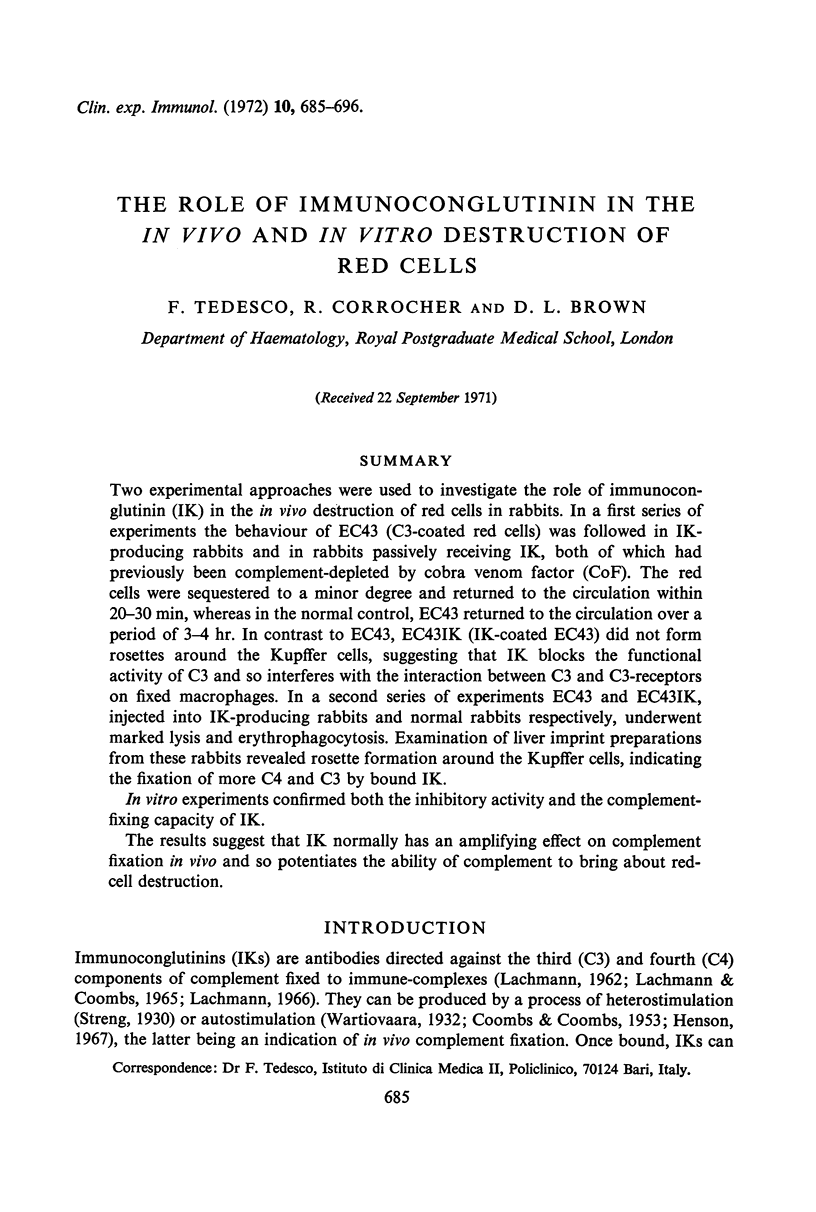
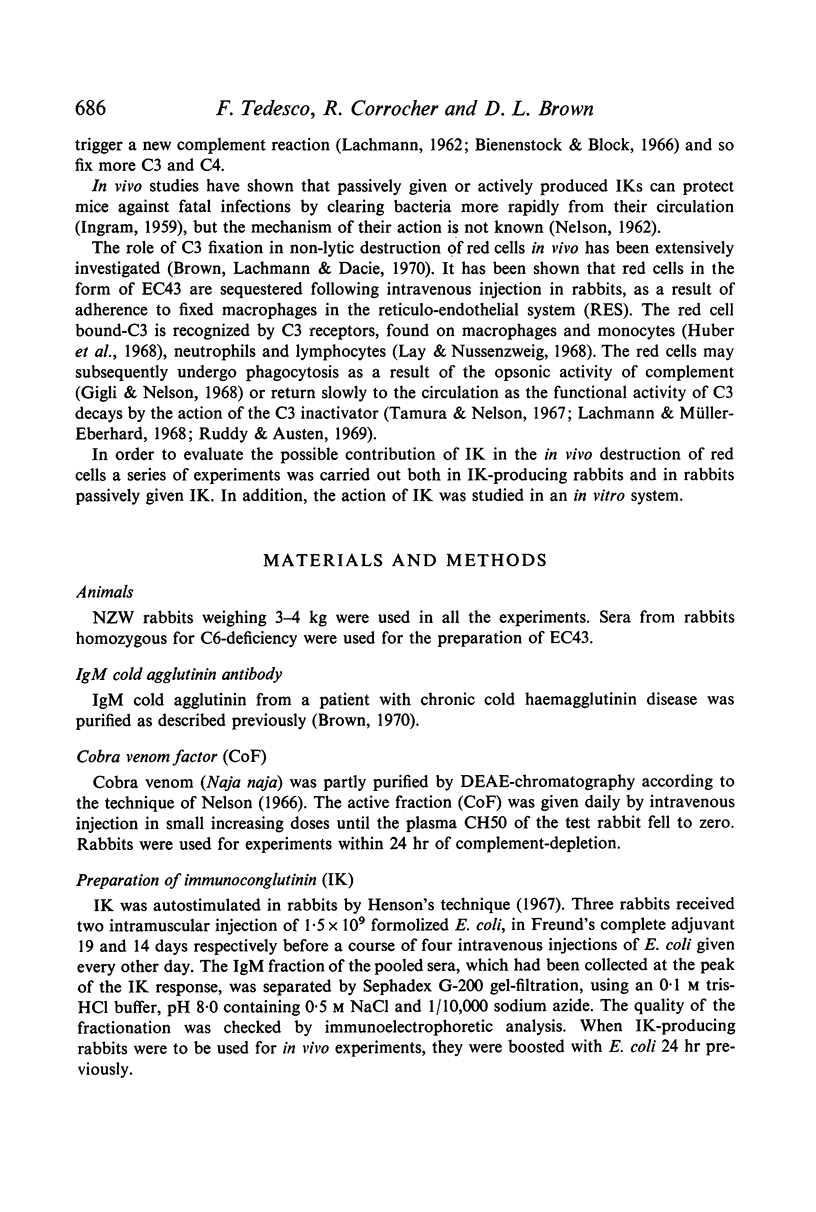
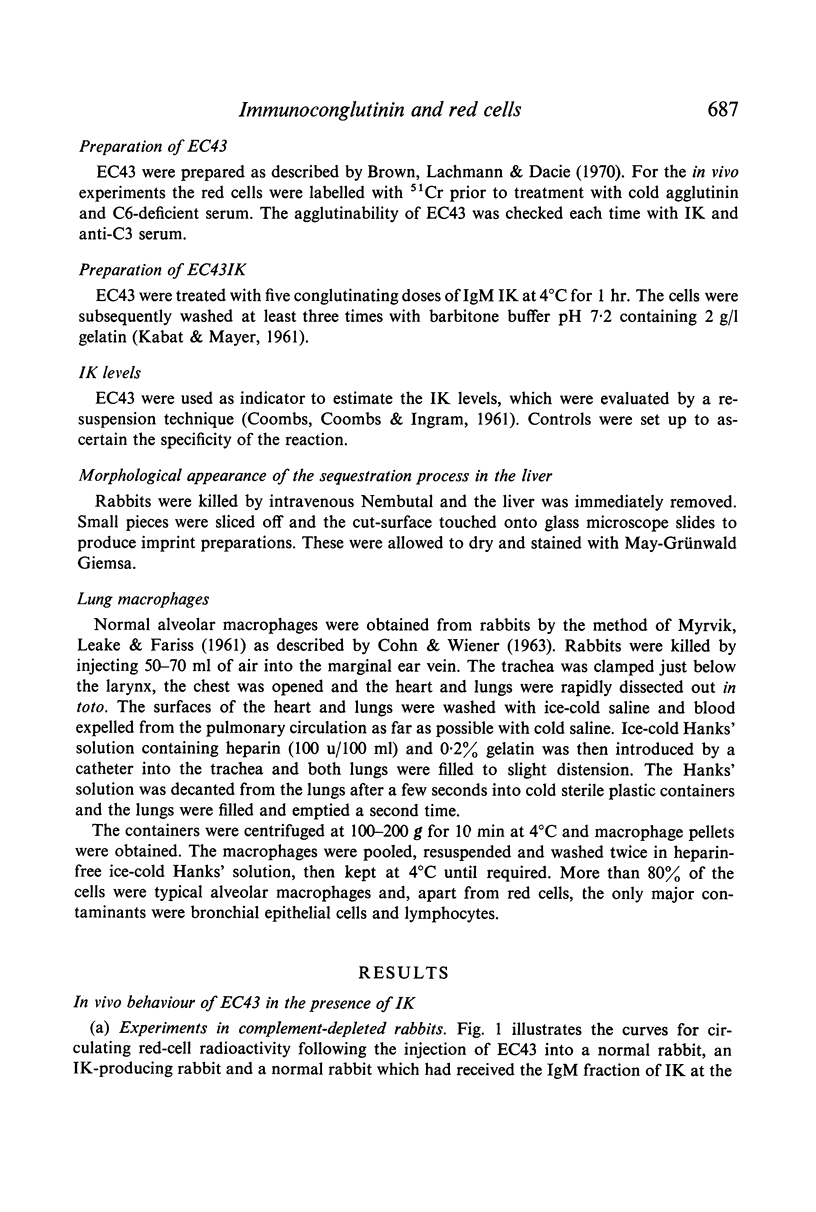
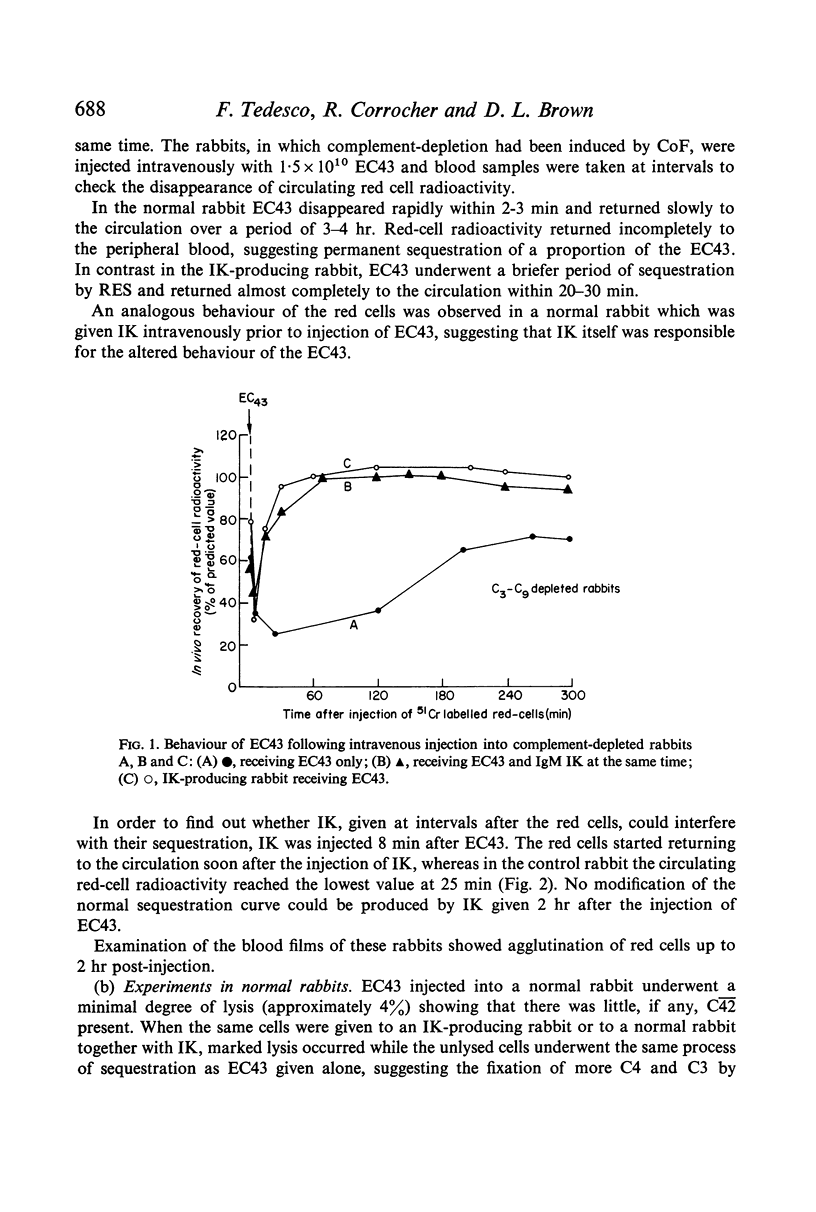
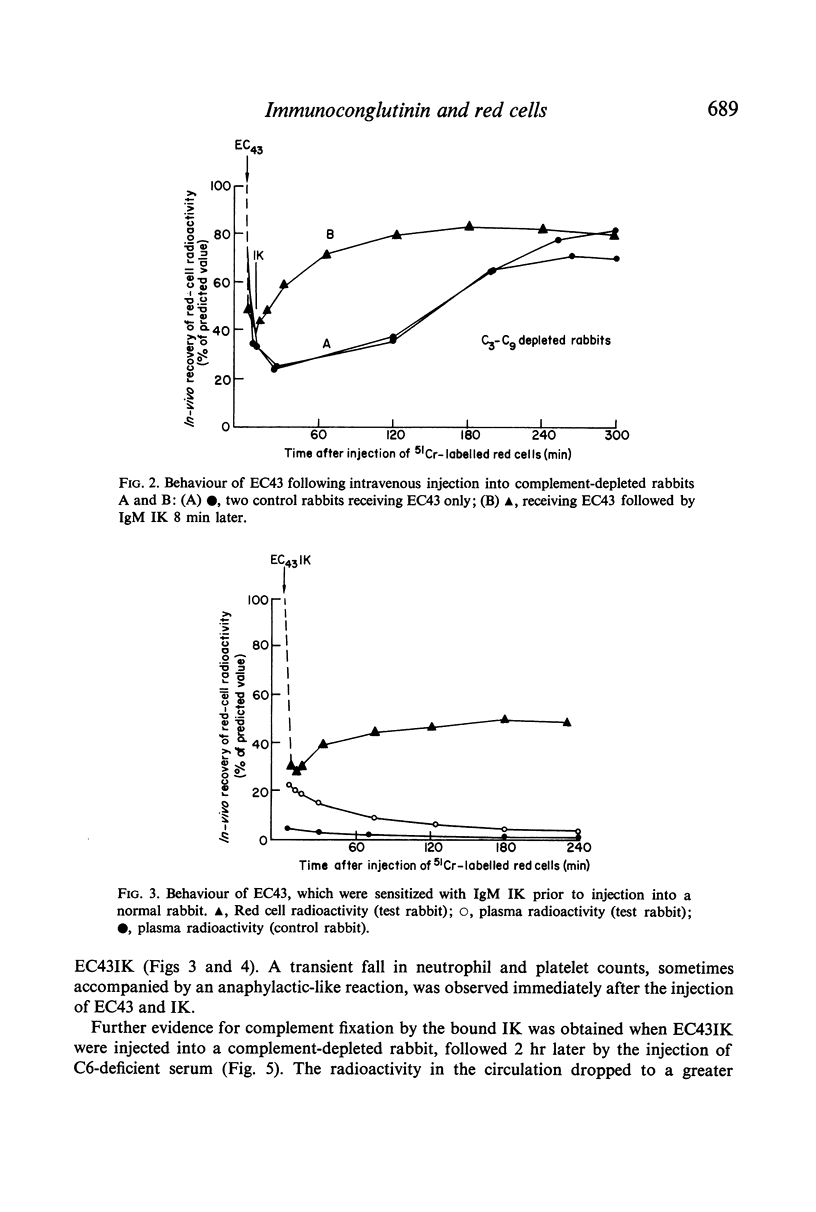
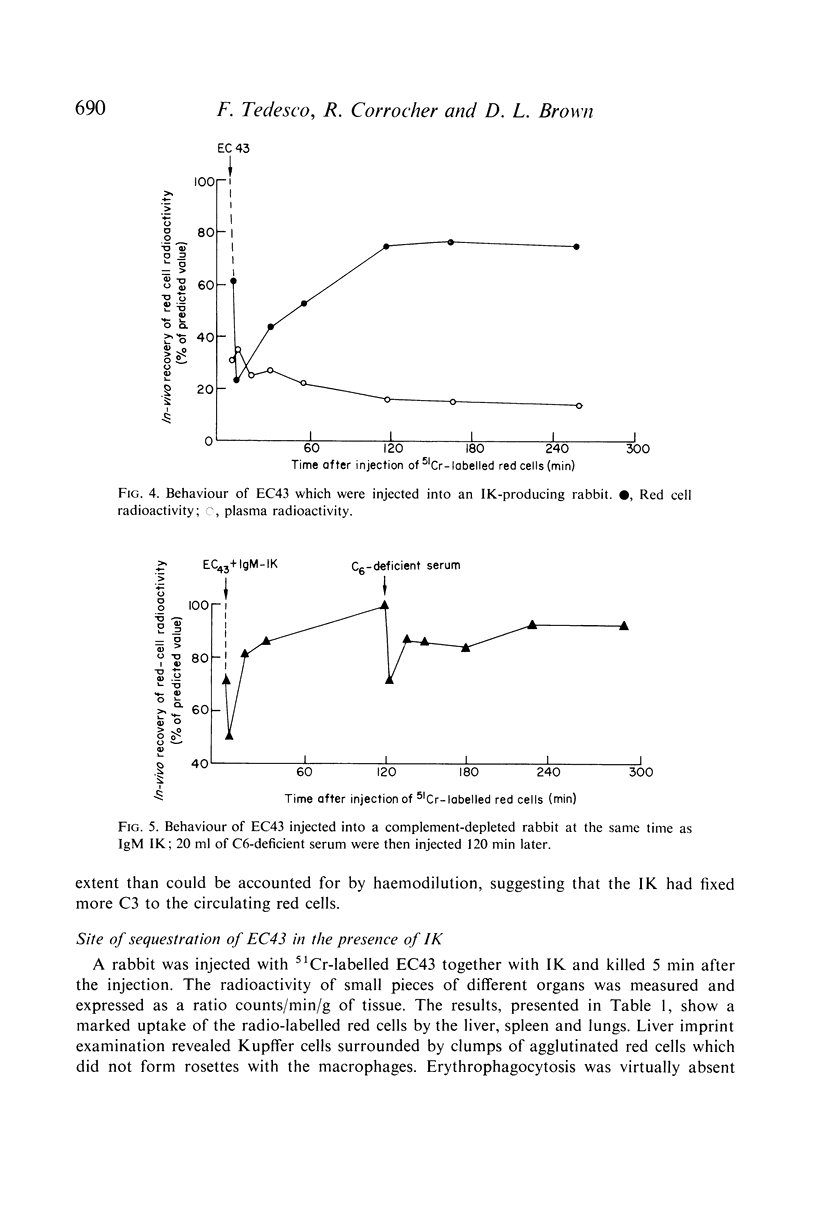
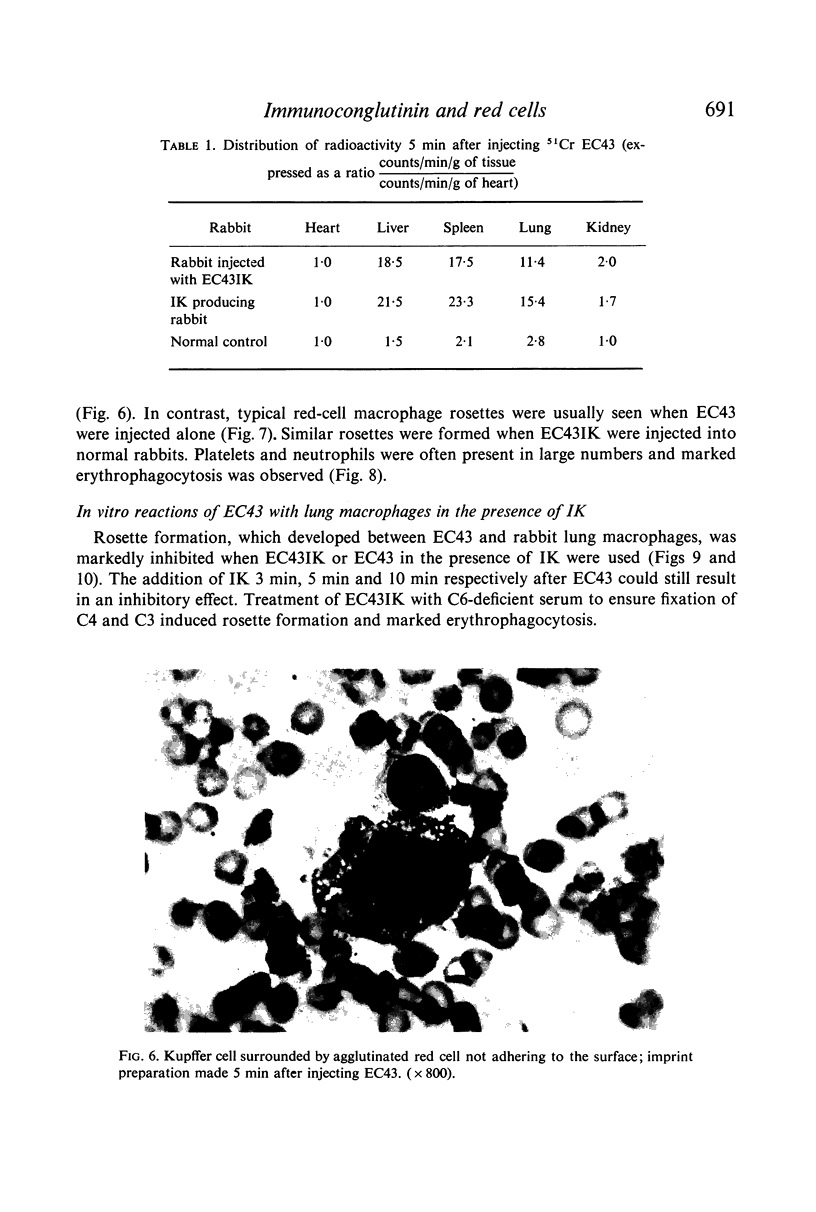

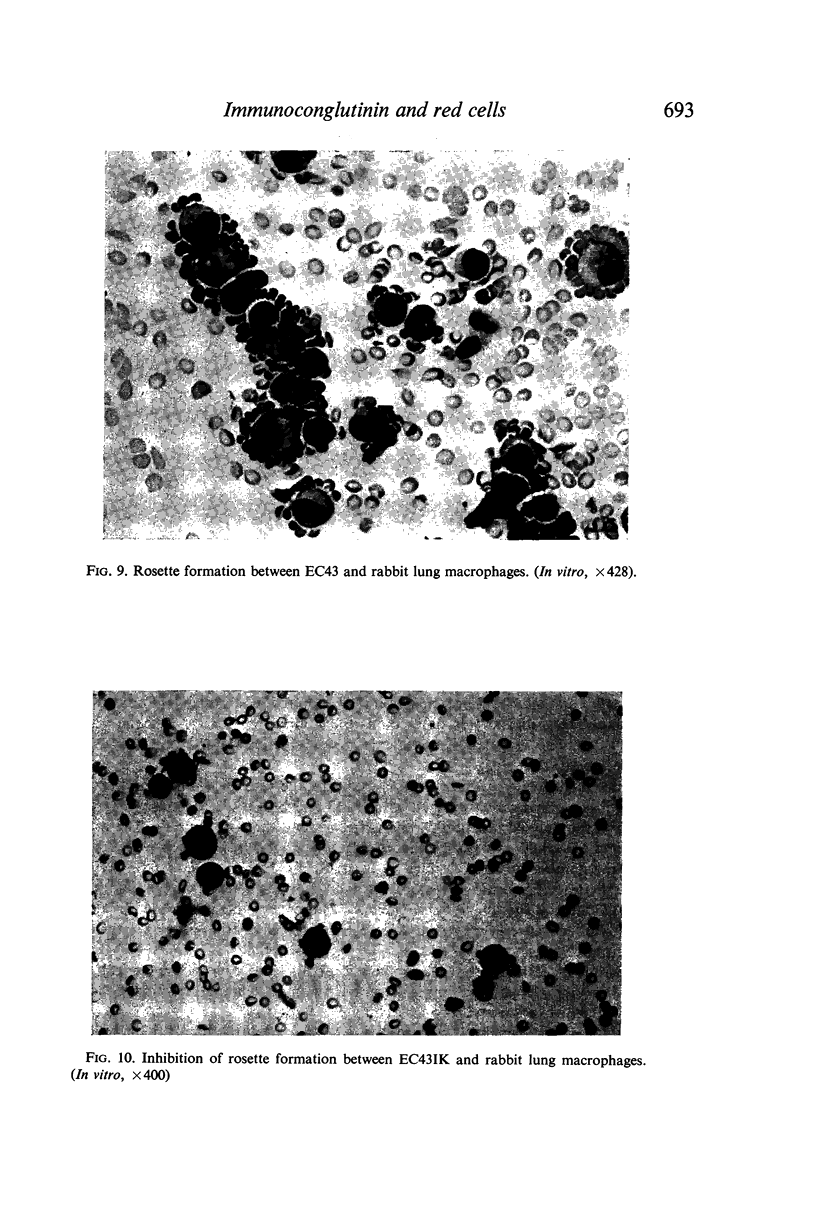
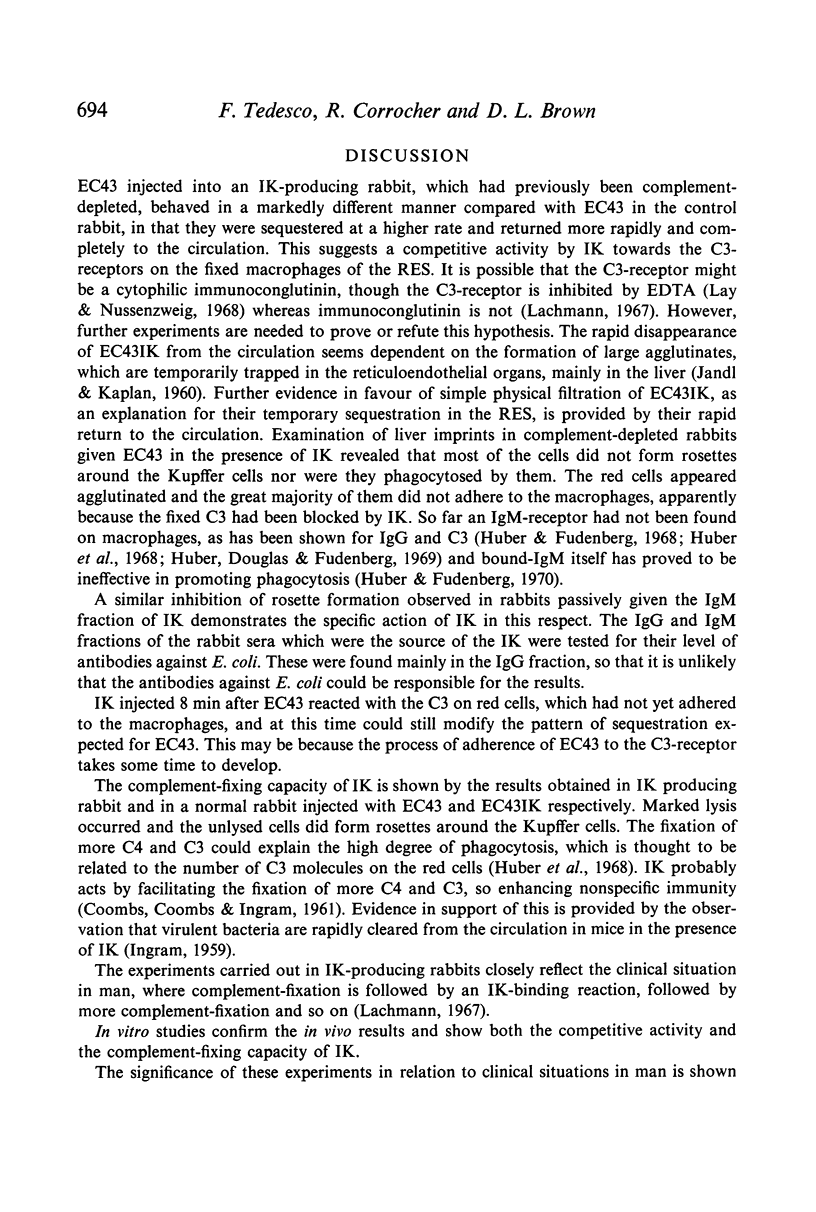
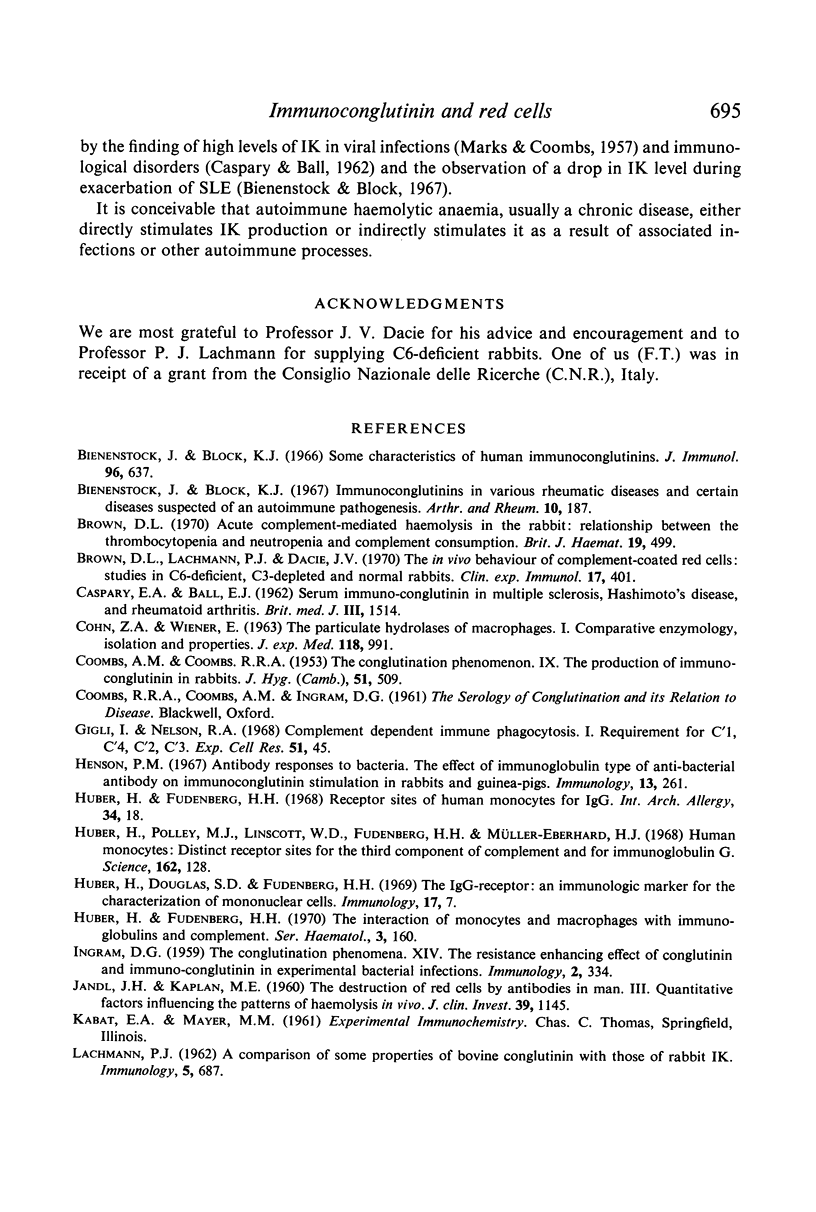
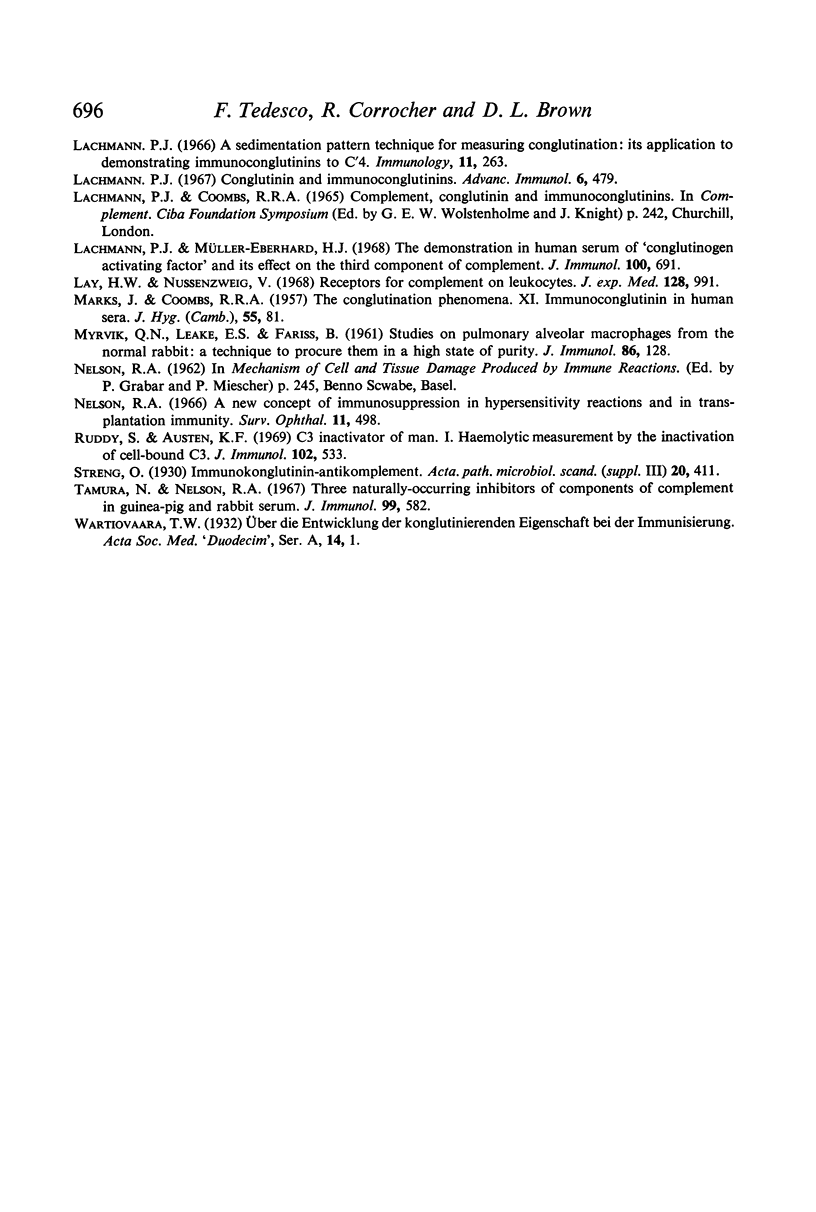
Images in this article
Selected References
These references are in PubMed. This may not be the complete list of references from this article.
- Bienenstock J., Bloch K. J. Immunoconglutinin in various rheumatic diseases and certain diseases suspected of an autoimmune pathogenesis. Arthritis Rheum. 1967 Jun;10(3):187–198. doi: 10.1002/art.1780100304. [DOI] [PubMed] [Google Scholar]
- Bienenstock J., Bloch K. J. Some characteristics of human immunoconglutinin. J Immunol. 1966 Apr;96(4):637–645. [PubMed] [Google Scholar]
- Brown D. L. Acute complement-mediated haemolysis in the rabbit: relationship between the thrombocytopenia and neutropenia and complement consumption. Br J Haematol. 1970 Oct;19(4):499–513. doi: 10.1111/j.1365-2141.1970.tb06978.x. [DOI] [PubMed] [Google Scholar]
- Brown D. L., Lachmann P. J., Dacie J. V. The in vivo behaviour of complement-coated red cells: studies in C6-deficient, C3-depleted and normal rabbits. Clin Exp Immunol. 1970 Sep;7(3):401–421. [PMC free article] [PubMed] [Google Scholar]
- CASPARY E. A., BALL E. J. Serum immuno-conglutinin in multiple sclerosis, Hashimoto's disease, and rheumatoid arthritis. Br Med J. 1962 Dec 8;2(5318):1514–1515. doi: 10.1136/bmj.2.5318.1514. [DOI] [PMC free article] [PubMed] [Google Scholar]
- COHN Z. A., WIENER E. THE PARTICULATE HYDROLASES OF MACROPHAGES. I. COMPARATIVE ENZYMOLOGY, ISOLATION, AND PROPERTIES. J Exp Med. 1963 Dec 1;118:991–1008. doi: 10.1084/jem.118.6.991. [DOI] [PMC free article] [PubMed] [Google Scholar]
- COOMBS A. M., COOMBS R. R. The conglutination phenomenon. IX. The production of immuno-conglutinin in rabbits. J Hyg (Lond) 1953 Dec;51(4):509–531. doi: 10.1017/s0022172400036792. [DOI] [PMC free article] [PubMed] [Google Scholar]
- Gigli I., Nelson R. A., Jr Complement dependent immune phagocytosis. I. Requirements for C'1, C'4, C'2, C'3. Exp Cell Res. 1968 Jul;51(1):45–67. doi: 10.1016/0014-4827(68)90158-4. [DOI] [PubMed] [Google Scholar]
- Henson P. M. Antibody responses to bacteria. The effect of the immunoglobulin type of anti-bacterial antibody on immunoconglutinin stimulation in rabbits and guinea-pigs. Immunology. 1967 Sep;13(3):261–274. [PMC free article] [PubMed] [Google Scholar]
- Huber H., Douglas S. D., Fudenberg H. H. The IgG receptor: an immunological marker for the characterization of mononuclear cells. Immunology. 1969 Jul;17(1):7–21. [PMC free article] [PubMed] [Google Scholar]
- Huber H., Fudenberg H. H. Receptor sites of human monocytes for IgG. Int Arch Allergy Appl Immunol. 1968;34(1):18–31. doi: 10.1159/000230091. [DOI] [PubMed] [Google Scholar]
- Huber H., Fudenberg H. H. The interaction of monocytes and macrophages with immunoglobulins and complement. Ser Haematol. 1970;3(2):160–175. [PubMed] [Google Scholar]
- INGRAM D. G. The conglutination phenomenon. XIV. The resistance enhancing effect of conglutinin and immuno-conglutinin in experimental bacterial infections. Immunology. 1959 Oct;2:334–345. [PMC free article] [PubMed] [Google Scholar]
- JANDL J. H., KAPLAN M. E. The destruction of red cells by antibodies in man. III. Quantitative factors influencing the patterns of hemolysis in vivo. J Clin Invest. 1960 Jul;39:1145–1156. doi: 10.1172/JCI104129. [DOI] [PMC free article] [PubMed] [Google Scholar]
- LACHMANN P. J. A comparison of some properties of bovine conglutinin with those of rabbit immuno-conglutinin. Immunology. 1962 Nov;5:687–705. [PMC free article] [PubMed] [Google Scholar]
- Lachmann P. J. A sedimentation pattern technique for measuring conglutination: its application to demonstrating immunoconglutinins to C'4. Immunology. 1966 Sep;11(3):263–271. [PMC free article] [PubMed] [Google Scholar]
- Lachmann P. J. Conglutinin and immunoconglutinins. Adv Immunol. 1967;6:479–527. doi: 10.1016/s0065-2776(08)60527-1. [DOI] [PubMed] [Google Scholar]
- Lachmann P. J., Müller-Eberhard H. J. The demonstration in human serum of "conglutinogen-activating factor" and its effect on the third component of complement. J Immunol. 1968 Apr;100(4):691–698. [PubMed] [Google Scholar]
- Lay W. H., Nussenzweig V. Receptors for complement of leukocytes. J Exp Med. 1968 Nov 1;128(5):991–1009. doi: 10.1084/jem.128.5.991. [DOI] [PMC free article] [PubMed] [Google Scholar]
- MARKS J., COOMBS R. R. The conglutination phenomenon. XI. Immunoconglutinin in human sera. J Hyg (Lond) 1957 Mar;55(1):81–90. doi: 10.1017/s0022172400061271. [DOI] [PMC free article] [PubMed] [Google Scholar]
- MYRVIK Q., LEAKE E. S., FARISS B. Studies on pulmonary alveolar macrophages from the normal rabbit: a technique to procure them in a high state of purity. J Immunol. 1961 Feb;86:128–132. [PubMed] [Google Scholar]
- Nelson R. A., Jr A new concept of immunosuppression in hypersensitivity reactions and in transplantation immunity. Surv Ophthalmol. 1966 Aug;11(4):498–505. [PubMed] [Google Scholar]
- Ruddy S., Austen K. F. C3 inactivator of man. I. Hemolytic measurement by the inactivation of cell-bound C3. J Immunol. 1969 Mar;102(3):533–543. [PubMed] [Google Scholar]
- Tamura N., Nelson R. A., Jr Three naturally-occurring inhibitors of components of complement in guinea pig and rabbit serum. J Immunol. 1967 Sep;99(3):582–589. [PubMed] [Google Scholar]







